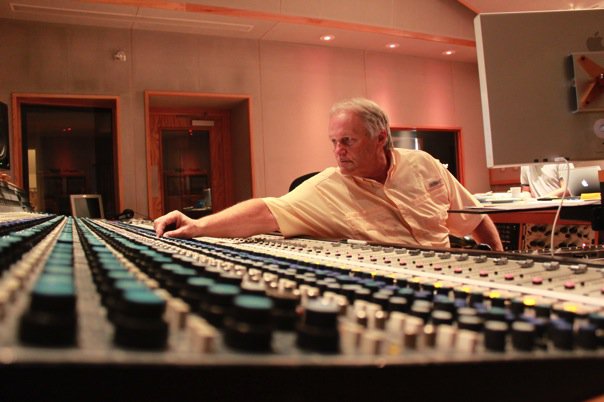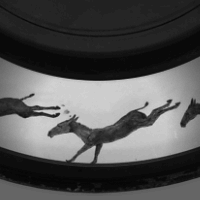|
Clapperboard
A clapperboard, also known as a dumb slate, clapboard, film clapper, film slate, bertolo clapz, movie slate, or production slate, is a device used in filmmaking, television production and video production to assist in synchronizing of picture and sound, and to designate and mark the various scenes and takes as they are filmed and audio-recorded. It is operated by the clapper loader. It is said to have been invented by Australian filmmaker F. W. Thring. Due to its ubiquity on film sets, the clapperboard is frequently featured in behind-the-scenes footage and films about filmmaking, and has become an enduring symbol of the film industry as a whole. History In the silent era the principal requirement of film stock identification during a day's shoot was the slate. The clapper as two sticks hinged together was invented by F. W. Thring (father of actor Frank Thring), who later became head of Efftee Studios in Melbourne, Australia. The clapperboard with both the sticks and sla ... [...More Info...] [...Related Items...] OR: [Wikipedia] [Google] [Baidu] |
Clapper Loader
A clapper loader or second assistant camera (2nd AC) is part of a film crew whose main functions are that of loading the raw film stock into camera magazines, operating the clapperboard (slate) at the beginning of each take, marking the actors as necessary, and maintaining all records and paperwork for the camera department. The name "clapper loader" tends to be used in the United Kingdom and Commonwealth, while "second assistant camera" tends to be favored in the United States, but the job is essentially the same whichever title is used. The specific responsibilities and division of labor within the department will almost always vary depending on the circumstances of the shoot. Functions Clapper loaders have a very important role as practically the only people on set who directly and physically oversee the state of the undeveloped Negative (photography), negative. The loader – the only person who actually handles the negative between the manufacturer and the laboratory � ... [...More Info...] [...Related Items...] OR: [Wikipedia] [Google] [Baidu] |
Film Editing
Film editing is both a creative and a technical part of the post-production process of filmmaking. The term is derived from the traditional process of working with film stock, film which increasingly involves the use Digital cinema, of digital technology. When putting together some sort of video composition, typically, one would need a collection of shots and footages that vary from one another. The act of adjusting the shots someone has already taken, and turning them into something new is known as film editing. The film editor works with raw footage, selecting Shot (filmmaking), shots and combining them into Sequence (filmmaking), sequences which create a finished Film, motion picture. Film editing is described as an art or skill, the only art that is unique to cinema, separating filmmaking from other art forms that preceded it, although there are close parallels to the editing process in other art forms such as poetry and novel writing. Film editing is an extremely important ... [...More Info...] [...Related Items...] OR: [Wikipedia] [Google] [Baidu] |
Double-system Recording
Double-system recording is a form of sound recording used in motion picture production whereby the sound for a scene is recorded on a tape machine that is separate from the camera or picture-recording apparatus. Double-system recording is the standard procedure on motion pictures that are originally photographed on film. Recording sound-on-film directly at the time of photography has several technical limitations, and no professional motion picture camera supports this option, so all production sound is recorded on a separate recorder. This procedure requires that both camera and sound recorder share a very accurate time reference, and that the speed of the camera and sound recorders be carefully governed. Originally this was done with an electro-mechanical interlock between the camera and recorder, necessitating a physical link, a cable, between recorder and camera. As quartz-based timers came into common use, film cameras and sound recorders adopted these, and these were ... [...More Info...] [...Related Items...] OR: [Wikipedia] [Google] [Baidu] |
Audio Engineer
An audio engineer (also known as a sound engineer or recording engineer) helps to produce a recording or a live performance, balancing and adjusting sound sources using equalization, dynamics processing and audio effects, mixing, reproduction, and reinforcement of sound. Audio engineers work on the "technical aspect of recording—the placing of microphones, pre-amp knobs, the setting of levels. The physical recording of any project is done by an engineer…" Sound engineering is increasingly viewed as a creative profession and art form, where musical instruments and technology are used to produce sound for film, radio, television, music and video games. Audio engineers also set up, sound check and do live sound mixing using a mixing console and a sound reinforcement system for music concerts, theatre, sports games and corporate events. Alternatively, ''audio engineer'' can refer to a scientist or professional engineer who holds an engineering degree and designs, deve ... [...More Info...] [...Related Items...] OR: [Wikipedia] [Google] [Baidu] |
Cut (transition)
In the post-production process of film editing and video editing, a cut is an abrupt, but usually trivial film transition from one sequence to another. It is synonymous with the term ''edit'', though "edit" can imply any number of transitions or effects. The cut, dissolve (film), dissolve, and wipe (transition), wipe serve as the three primary transitions. The term refers to the physical action of cutting film or videotape, but also refers to a similar edit performed in software; it has also become associated with the resulting visual "break". History Due to the short length of early film stock, Film splicer, splicing was necessary to join together segments into long-form. Actuality films, Actuality director (film), directors spliced together reels prior to Shot (film), shooting to record for longer periods of time. Narrative directors, on the other hand, preferred shooting for shorter lengths, editing together shot footage. In either case, film was cut (and subsequently joining t ... [...More Info...] [...Related Items...] OR: [Wikipedia] [Google] [Baidu] |
Movie Projector
A movie projector (or film projector) is an optics, opto-mechanics, mechanical device for displaying Film, motion picture film by projecting it onto a movie screen, screen. Most of the optical and mechanical elements, except for the illumination and sound devices, are present in movie cameras. Modern movie projectors are specially built video projectors (see also digital cinema). Many projectors are specific to a particular film gauge and not all movie projectors are film projectors since the use of film is required. Predecessors The main precursor to the movie projector was the magic lantern. In its most common setup it had a concave mirror behind a light source to help direct as much light as possible through a painted glass picture slide and a lens, out of the lantern onto a screen. Simple mechanics to have the painted images moving were probably implemented since Christiaan Huygens introduced the apparatus around 1659. Initially, candles and oil lamps were used, but oth ... [...More Info...] [...Related Items...] OR: [Wikipedia] [Google] [Baidu] |
Tape Head
''Tape Head'' is the seventh studio album by American rock band King's X, released in 1998 via Metal Blade Records. A music video was made for the song "Fade". "World" is a reworked song from the band's ''Sneak Preview'' demos. The controversial unreleased track "Quality Control" is included on the album, but has been re-titled to "Happy". The majority of the lyrics are now different, including the lack of profanity. The album cover picture is that of Doug Pinnick wrapped in recording tape. According to Pinnick, he brought the songs "Happy", "Cupid" and "Hate You", and Ty Tabor brought "Ocean" to the ''Tape Head'' recording sessions. All other songs were band created during the recording session. The song "Walter Bela Farkas" was recorded live August 8, 1996, at the Tramps nightclub in New York City. Track listing All songs written by King's X. Personnel * Doug Pinnick – bass, vocals * Ty Tabor – guitar, vocals * Jerry Gaskill – drums, vocals Additional ... [...More Info...] [...Related Items...] OR: [Wikipedia] [Google] [Baidu] |
Super 8 Film
Super 8 mm film is a motion-picture film format released in 1965 by Eastman Kodak as an improvement over the older "Double" or "Regular" 8 mm home movie format. The formal name for Super 8 is 8-mm Type S, distinguishing it from the older double-8 format, which is called 8-mm Type R. Unlike Super 35 (which is generally compatible with standard 35 mm equipment), the film stock used for Super 8 is not compatible with standard 8 mm film cameras. The film is nominally 8 mm wide, the same as older formatted 8 mm film, but the dimensions of the rectangular sprocket hole perforations along one edge are smaller, which allows for a larger image area. The Super 8 standard also allocates the border opposite the perforations for an oxide stripe upon which sound can be magnetically recorded. Fujifilm released a competing system named Single-8, also in 1965, which used the same film, image frame, and perforation dimensions, but with a different f ... [...More Info...] [...Related Items...] OR: [Wikipedia] [Google] [Baidu] |
Single-system Recording
Single system audio is the system of recording ''sound on film'' or ''SOF''. There are two methods of recording, the older method, optical and the later method, magnetic. SOF was primarily used for news film prior to the advent of portable videotape recording, but was used until recently for documentary film recording. Optical For optical recording, the film only had a single row of perforations and the area where the other set of perforations would have been was exposed to a small bright lamp inside the camera controlled by an amplifier (usually in a separate box) that would vary the area of recording ( RCA type), by means of shutters pulled back by variation in current, or variations in intensity (Western Electric type). Editing involved painting or taping over the optical track for the distance the sound led the film through the camera and projector. This would avoid the popping sound, but would result in a second of silence. Magnetic Magnetic recording had magnetic media in th ... [...More Info...] [...Related Items...] OR: [Wikipedia] [Google] [Baidu] |
Rolling Stone
''Rolling Stone'' is an American monthly magazine that focuses on music, politics, and popular culture. It was founded in San Francisco, California, in 1967 by Jann Wenner and the music critic Ralph J. Gleason. The magazine was first known for its coverage of rock music and political reporting by Hunter S. Thompson. In the 1990s, the magazine broadened and shifted its focus to a younger readership interested in youth-oriented television shows, film actors, and popular music. It has since returned to its traditional mix of content, including music, entertainment, and politics. The first magazine was released in 1967 and featured John Lennon on the cover, and was then published every two weeks. It is known for provocative photography and its cover photos, featuring musicians, politicians, athletes, and actors. In addition to its print version in the United States, it publishes content through Rollingstone.com and numerous international editions. The magazine experienced a rapid ... [...More Info...] [...Related Items...] OR: [Wikipedia] [Google] [Baidu] |





